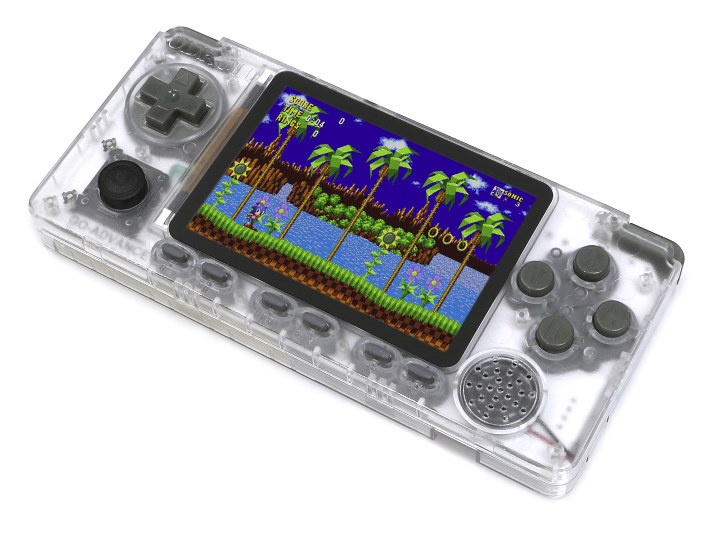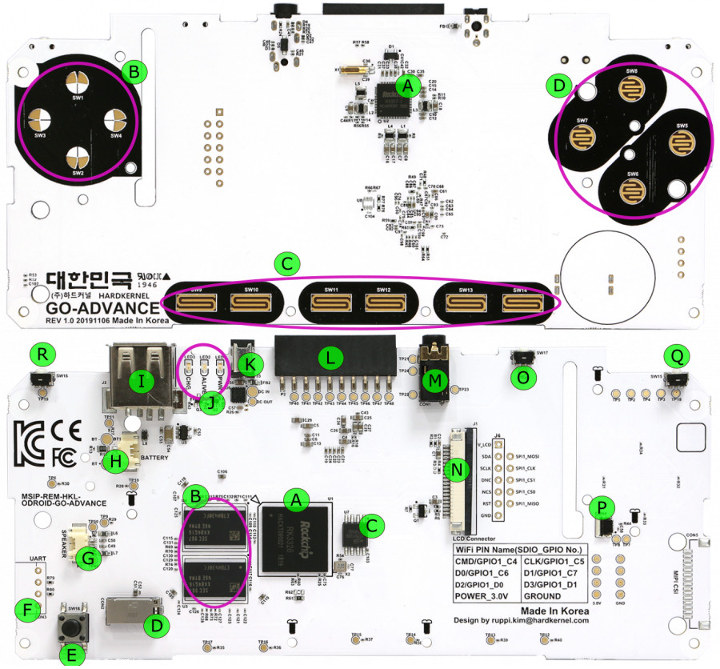Last year, Hardkernel took some time away from Arm and x86 Linux SBCs with the launch of ODROID-GO retro game console powered by Espressif Systems ESP32 processor.
The console could be programmed with the Arduino IDE, and the $32 price tag made it a popular item despite the limited processing power fo the ESP32 dual-core processor. The good news is that the console got an upgrade with ODROID-Go Advance equipped with a Rockchip RK3326 quad-core Cortex-A35 processor coupled with 1GB RAM to run Linux, and featuring an upgraded 3.5″ wide-viewing angle color display.

ODROID-GO Advance specifications:
- SoC – Rockchip RK3326 quad-core Arm Cortex-A35 processor @ 1.3GHz with Mali-G31 MP2 GPU
- System Memory – 1GB DDR3L @ 786Mhz, 32 Bits bus width
- Storage – 16MB SPI Flash for bootloader, Micro SD Card slot (UHS-1 Capable interface)
- Display – 3.5″ 320×480 TFT LCD (Wide-viewing angle display, MIPI-DSI interface)
- Audio – 3.5mm earphone stereo jack, 0.5Watt 8Ω Mono speaker
- USB – 1x USB 2.0 host port
- Input Buttons – F1, F2, F3, F4, F5, F6, A, B, X, Y, Direction Pad, Left Shoulder, Right Shoulder, Analog joystick
- Expansion – 10-pin header with I2C, GPIO, IRQ at 3.3Volt
- Battery
- 3.7V/3000mAh Li-Polymer battery
- Up to 10 hours of continuous game playing time
- Charging time – 2.5 to 3 hours when the device turns off. 4 to 5 hours while playing games.
- Power Supply – 5V/1.5A max via 2.5mm DC Jack
- Power consumption – Game emulation: 250~350mA, Power off: 0.1mA
- Dimensions – 155x72x20 mm
- Weight – 170 grams

The console runs Ubuntu 18.04 64-bit with Linux 4.4.189 as well as a modified EmulationStation front-end with Libretro, and GPU accelerated OpenGL-ES on DRM-FB. This enables emulation of the following platforms in the trial BSP:
- Atari 2600, Atari 5200, Atari 7800, Atari Lynx
- SEGA Game Gear
- Nintendo Game Boy, Game Boy Advance (gba), Game Box Color (gbc)
- SEGA Master System, Mega Drive (aka Genesis)
- Nintento NES, SNES
- NEC PC Engine (TurboGrafx-16), PC Engine CD
- Sony PlayStations (PSX), Portable Play Station (PSP)
- Sega CD (Mega CD)
More game console are likely to be supported over time. You can see some of the games running on ODROID-GO Advance in the video below including Sonic 3 on Genesis, Tekken 6 & Patapon on PSP, Final Fantasy VII on PlayStation One, Super Mario Kart on SNES and several others.
ODROID-Go Advance is in the final stages of development, and Hardkernel will send some engineering samples to community developers next week to improve the software. The game console will be sold for $55 at the end of January 2020. You’ll find more details in the Wiki and the forum thread announcing the new console.
Thanks to Tim for the tip.

Jean-Luc started CNX Software in 2010 as a part-time endeavor, before quitting his job as a software engineering manager, and starting to write daily news, and reviews full time later in 2011.
Support CNX Software! Donate via cryptocurrencies, become a Patron on Patreon, or purchase goods on Amazon or Aliexpress






Looks great. Hopefully you can buy more than one of them when they release to justify the shipping. 😀
I think using a barrel connector for power instead of a micro USB is a major mistake. Plenty of real estate for the USB. Also, as it’s using a 64-bit Linux, 2GB of RAM would have been better.
I think Type C would have been nice but micro USB just plain sucks, especially since my children have broken every single device I’ve even given them with this connector.
I would rather have USB to barrel vs Micro USB.
I’ve never broken a micro USB port, nor my wife or children. Maybe teach your kids to handle electronics better?
Well my son just passed away the end of October from lymphoma after a year and a half battle, he had just turned 21. My other son is 23 and my daughter is 18, so I guess it’s a little late to teach them.
Blaming me for not teaching them is a ridiculous notion, unless you hover over your children all the time it’s a bit difficult to see what they do to the things we buy them.
They are (were) old enough that they had to switch from Mini USB which was a more durable connector to Micro USB when they were still young, so it had little to do with me and more to do with a connector that could just be plugged in or not to a connector that can break if not carefully inserted the correct way.
Barrel jacks are so long that snapping them has been easier in my experience. That and the whole different barrel sizes for no reason thing (I have 19V devices with big bodies but smaller barrels than 5V devices) puts me off.
I’ve never snapped one but if not the correct length they can get finicky in less than a year of use.
There is no perfect connector unfortunately, something magnetic would be nice but then that’s proprietary and no one wants that.
Ironically, for its device class, the amount of RAM is very generous. 64MB to 256MB is typical for this configuration.
When the product ships, other developers can verify that 70% of RAM goes unused running its applications (emulators). The “large” amount of RAM makes on-device development possible.
With a WiFi or BT USB adapter it can possibly make a nice and cheap central console for home automation. I’m still using my GO for everything but games, as a thermal camera, GPS, oscilloscope, etc… But it lacks the ability to develop large applications. Now this could become possible.
Sounds interesting as i’m a bit into home automation these days. Time to elaborate a bit more?
why the heck they put a 16:9 screen on it? They should know better. None of the consoles this device is able to emulate does put out a picture in that relation. Why not use a 4:3 screen? Such a disappointment
It’s not 16:9. It’s 3:2 stretched.
that not makes it better. Still not used screen space on the left and right.
It’s still a Ubuntu you can probably watch Netflix on it though the mono speaker defeats that
Headphone jack.
Pretty potent handheld and certainly one of the more powerful ones (It beats out on the Powkiddy X18, for reference). Part of it is in due with the Mali G31 MP2. Also used in tv boxes, it has more pixel throughput (2.6 gpix) than a Radeon HD 6320.
That by itself does not say much, but its also faster than a Mali T820 MP3, has OpenGLES 3 and Vulkan support, and then some. For this price, and with Linux, this is a fairly epic part to have.
Sadly, there aren’t that much specific games for it, and if you want to use any graphical might, you have to turn to Android, which may or may not run these games as most of them require 2 GB minimum RAM, which the Odroid Go Advance does not have.
So, powerful stuff for its price and at that resolution, but if it can be fully harnessed? The jury’s verdict is still out on that one.
I honestly wish I knew that hardKernel was planning it. I bought a PS Vita about 2 months ago for playing PS games and some emulators. This one is pretty interesting, but I think PS Vita does everything better than Go Advance. That being said, this is better than any devices that want to be portable/handheld emulators.